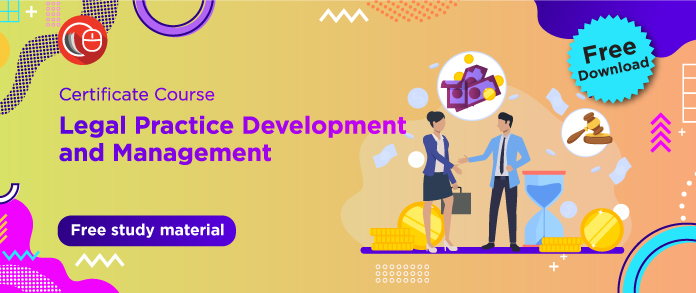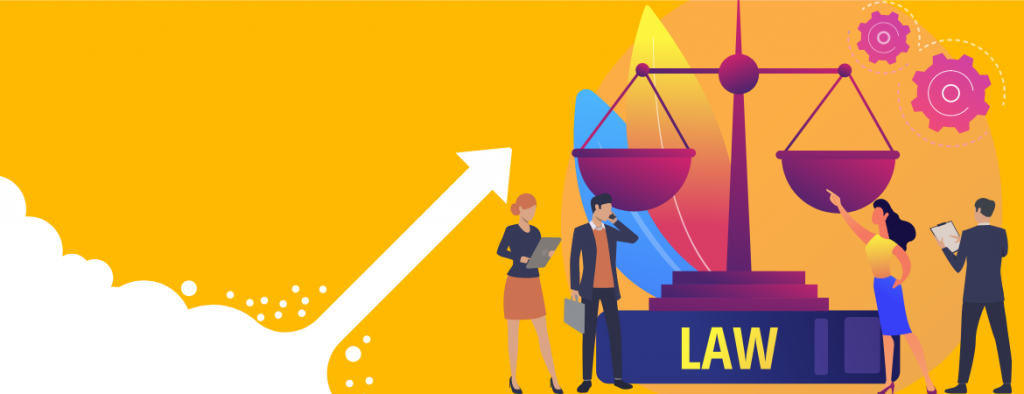The decision to start independent practice is a brave one. It is also filled with numerous fears and insecurities.
How will I find my first client?
How can I consistently generate new clients?
Why will clients trust me?
Is it really possible for me to compete with law firms?
Can I build a highly profitable practice? How can it continue to grow over time?
I want you to examine these questions in the light of three stereotypes, which prevent us from realising our full potential as independent practitioners.
These stereotypes belong to the pre-1990s era, when litigation was the primary career option for a graduating lawyer.
Today, even though times are vastly different, these stereotypes limit what we can achieve.
#1 – Independent practitioners must depend on litigation in courts to earn their livelihood
Litigation is the primary focus for anyone who starts independent practice these days.
However, this thought process is a relic belonging to the pre-liberalization era. Prior to 1991, foreigners could not enter India and do business.
Even local entrepreneurs needed a license to start a business in India in most sectors, and getting a license was difficult owing to bureaucracy and corruption.
Therefore, there was less of a need for lawyers, than those who could engage with the government.
The only option available to practice law was to pursue litigation in courts.
The few law firms which existed, primarily worked on litigation and conveyancing work.
Before the ‘90s, the country’s biggest law firms were approximately 30-50 lawyers strong.
Times today are very different.
There has been an explosion of new practice areas such as general corporate, M&A, banking and finance, capital markets, technology, intellectual property laws practice, arbitration, tax, white collar crime, regulatory, etc.
There is a huge volume of transactional and advisory work.
If you compare the headcount of the biggest Indian law firms in the 1990s to now, you will see that there has been exponential growth.
For example, Legal 500, a leading listings website for law firms across the globe, lists Cyril Amarchand Mangaldas as having 750 lawyers today!

What does this mean for independent practitioners?
Transactional and advisory work is not available for law firms alone, but independent practitioners have a huge opportunity to capitalise on it.
Let me tell you why.
Starting a new business has become easier in India. The velocity of company and LLP incorporation and tax registrations has increased with most of the government departments and ministries having an online process for the same.
Several new businesses are able to scale themselves and generate revenues really fast. They will not be of the size of a Reliance or a global MNC, but they are profitable, need legal assistance and are willing to pay lawyers for the same.
However, they cannot afford to pay the fees of a big law firm. They may be able to pay INR 30,000 for a shareholder agreement, or an ESOP plan, but they cannot pay INR 1.5 – 2 lakhs for it, which a law firm will charge.
These clients need assistance on various aspects such as:
- Business structuring,
- Securing necessary registrations with MCA, tax authorities, MSME ministry and any sectoral regulators
- Obtaining intellectual property protection,
- Executing co-founders agreements,
- Drafting the terms and conditions and various policies for their websites,
- Executing contracts with employees, vendors and distributors,
- Implementation of ESOP plans,
- Executing software development and services agreements,
- Review and drafting of investment contracts,
- Sending notices for IP infringement
- Responding to notices from regulatory authorities
Some of the startups may need help with POSH training, employment and code of conduct training, negotiation training, data protection training, etc.
There are many other services as well which independent practitioners can provide such clients.
This is altogether a new target audience for independent practitioners to tap into.
Independent practitioners who can provide these services to clients can be highly successful.
Note that a lot of this work can be performed by lawyers from anywhere in India. While most cities and towns have local startups and SMEs, if you can’t find a business situated in your location, you can easily perform such work remotely, for say, a startup based in Nagpur, or Mumbai, or Bangalore, or Pune.
In other words, it is not necessary to depend on litigation for a survival income or to build a career as an independent practitioner. In fact, you need not litigate at all, as there is enough transactional and advisory work to perform.
However, if you are passionate about litigation, you can continue to litigate alongside performance of such transactional and advisory work, which will keep your practice flourishing.
Further, performing transactional and advisory work to a client’s satisfaction can make you the go-to-lawyer for disputes proceedings
Let me explain how.
Imagine that you have sent a cease and desist notice to an entity which is using a logo which is similar to the one owned by your client. The entity is continuing to use the logo and has not responded.
Your client will need to file an infringement suit next. Whom do you think he or she will approach?
Imagine that a distributor has purchased certain products from your client as per the distribution contract but refuses to make payments. INR 15 lakhs is overdue. Your client has asked you to send a few notices but it hasn’t worked. The contract has an arbitration clause. Your client wants to identify subsequent steps.
What can you do?
- Initiate arbitration proceedings.
- Review and amend future contracts to tighten payment provisions for other distributors.
If you do not litigate yourself, you can always refer this work to another lawyer, who will be grateful for having referred a client.
You may need to oversee the process to ensure that the client is equally satisfied with the outcome of the litigator. That may require you to possess additional knowledge of litigation and arbitration, even if you do not perform the work yourself.
#2 – It takes years to develop your own clients – start training with a senior first and do not expect returns for the first 10 years
If you are working with a senior whose primary practice is in litigation, chances are that he or she established his practice somewhere in the 1990s or in the 2000s.
They started training with a senior and gradually became independent. As their senior’s practice grew, their senior started passing some matters to them. They also secured some of their own clients over the years.
If you want to build your practice in this way, it will take you these many years even now.
However, you might be missing a very important opportunity here.
There are many new ways of generating clients in today’s times.
I know of several independent practitioners who started independent practice between 2010-2017 and started earning more than a Tier 1 law firm associate in 2-3 years.
These independent practitioners did not focus on litigation alone as their primary source of income, and started seeking out their own clients for corporate work.
In time, they also started getting their own clients for litigation work.
There are several pitfalls of depending on seniors exclusively for training.
First, you will only learn the techniques that they know from their experience. Their experiences are based on their ambitions and journey. Your ambitions may be different, and you do not want to be limited by someone else’s worldview while exploring the full potential of your career.
Second, you do not want to drain your senior’s time by also depending on them to train you, and then expect them to pay you to meet your expenses. Instead, if you can learn by using various resources and tools available today, you stand a greater chance of contributing to your senior’s practice.
Third, internet penetration was not as high even five years earlier as it is today in India. Most of the seniors would not have used the internet to build their credibility in the initial phases of their practice, which is important for you to do.
Four years back, in 2016, we conducted a pilot with Cliklawyer, a legal solutions company, which was built from scratch to a monthly revenue rate of 8 lakhs per month in six months, that is, an annual run rate of INR 1 crore.
You do not need years of training with a senior, but instead a client-focussed approach that you deploy in all your work.
#3 – Word of mouth is the only sustainable way to secure new clients – all other efforts to network and build your credibility online are fruitless or cheap
While word of mouth helps in the long run, no one in the information age exclusively depends on it in the short term, if they want to grow.
Definitely, there are practitioners who already have their hands full with existing clients, and who cannot handle more than 1 new client in say about two months, because they are already so busy.
If you are in that situation, you can depend on word of mouth.
If you want to grow and obtain new clients, dependence on word of mouth approach alone will not let you survive long enough in the market.
In reality, this stereotype is also based on the era where arguing in the courtroom was the only work that a lawyer could perform.
Briefing counsels, or a CFO or in-house counsel of a different company, would hear the arguing counsel’s performance in the courtroom, and recommend the counsel’s name to their corporate clients for high-stakes matters.
If you argued well, they would recommend you to their clients.
Today, clients need various kinds of legal advisory and transactional work to be performed by lawyers.
This work may not involve litigation proceedings. Even where litigation is needed, it is envisaged as the last stage in a series of steps.
For such advisory and transactional work, courtroom performance is not relevant. In fact, performance in a courtroom and as a transactional lawyer require different skill sets.
How do clients find lawyers for such work in that case?
Like everyone else, clients also prefer to search about their problems on the internet to learn more.
If they find your content through search engine results, or see posts of a friend on their social media sharing your content, they may learn more about the nuances of the issue that they are facing.
They may even inquire about the person who wrote the content.
If they search more, and find more relevant content posted by you, they will perceive you as someone skilled in the area, and consider reaching out to you.
What you need to do next is to have a process to translate such incoming queries into paid client work, over a series of conversations. I will discuss more about this later.
For now, note that this is why it is important for an independent practitioner to take out time to build his or her credibility online on a regular basis.
You must also appreciate that clients are highly educated about their legal needs due to the volume of information available on the internet.
They may also have approached multiple lawyers before finding you, so their understanding of their problem would have definitely improved.
They will quickly walk away if you show any lack of knowledge, or take a pedantic approach to situations.
I have heard examples of how independent lawyers never heard back from a client who approached them for help for contract drafting work in connection with their business.
Do you know why?
Because the lawyer asked the client to first check if they needed a license for their business. The business did not pertain to a licensed industry.
Rather than speaking to the client about the contracts, and about conducting a preliminary search to confirm whether a license was needed or not, the lawyer gave the client some homework to do and did not proceed forward with exploring the need of the client further.
Now, imagine what happens when a potential client hears such a response from a lawyer in connection with his or her business.
It is not a mystery why the lawyer did not hear back from the client.
Hence, your work needs to show that you are on top of your game. This applies to content that you publish on the internet as well.
It increases the chances of incoming queries, which can later translate into paid clients.
Please note that I do not support soliciting work on the internet in any way. That is not permitted.
To build your credibility, create educational and authoritative content on the internet and continuously share knowledge with your target audience, so that you are on top of their mindspace, when they face a legal issue.
The ability to use the internet flattens the world of lawyers. It demolishes any kind of feudal hierarchies between second generation and first generation lawyers, between NLU and non-NLU graduates, between the haves and the have-nots.
This ability is equally available to all lawyers, irrespective of their experience or heritage.
Several Indian law firms have taken the approach of publishing a volume of valuable content online.
For example, Cyril Amarchand Mangaldas has a regularly updated blog.
AZB & Partners has periodic client alerts on their website, which are also sent via email to their mailing list.
Trilegal has a Youtube channel.
Nishith Desai and Associates has produced the most volume of content, and was probably the earliest to start publishing content on the internet. See their research papers here.
Now, it is possible for independent practitioners to build a website and an online content strategy that is equally powerful.
You may need to acquire a few new legal skill-sets around the services that such non-litigation clients need, develop your writing skills and write frequently, use a few plug and play tools to build a website and a blog, send your blog posts for publication on external blogs such as iPleaders blog and then repeat.
You will notice a huge growth in your perception by a target audience and the volume of incoming queries.
I will discuss more about building a content strategy later.
If you are interested, please share your whatsapp number and email with us so we can add you to a WhatsApp group we have specifically curated for lawyers.
https://chat.whatsapp.com/IZ43MinlJvIGL4wsPzZPFN
You will also get access to some other amazing resources through the group as well.
Students of Lawsikho courses regularly produce writing assignments and work on practical exercises as a part of their coursework and develop themselves in real-life practical skills.
LawSikho has created a telegram group for exchanging legal knowledge, referrals, and various opportunities. You can click on this link and join:
https://t.me/lawyerscommunity2
Follow us on Instagram and subscribe to our YouTube channel for more amazing legal content.






 Allow notifications
Allow notifications
